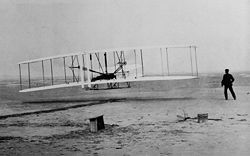Wright brothers
Wilbur and Orville Wright, collectively known as the Wright brothers, were important early aviation pioneers. They are best known for their first flight in a self-powered, controlled, heavier-than-air aircraft at Kitty Hawk, North Carolina on December 17, 1903. They went on to develop fixed-wing aircraft technology in their hometown of Dayton, Ohio.
Biography
Born in Dayton, Ohio, the Wright brothers were printers and bicycle builders before their interest turned to aviation.
Neither brother ever married or had a publicly acknowledged romantic relationship.
Wilbur died in 1912.
Controversies
First flight
Although the Wright brothers receive universal acclaim for their critical advances in the field of aircraft control, specifically control of roll around the longitudinal axis, the assignment of credit for the invention of the "first airplane" is not universal. Some of the disagreements center around technical issues. Some are driven by nationalism.
On technical grounds, critics of the brothers' claim as "first to fly" point to the fact that their early aircraft were unable to take-off from a without the assistance of launch rails, strong headwinds, or (in later days) catapults.
Supporters of the Wright's primacy in powered heavier-than-air flight counter that the use of headwinds and a launch rail were conveniences rather than necessities. The soft sand at Kitty Hawk (and later the rough ground at Huffman Prairie) made wheeled undercarriages impractical. Further, headwinds were required in order to avoid the need for extremely long launch rails. These supporters further contend that had the Wrights attempted their flights on the smooth parkland used by other pioneers, the Wrights might have made other design choices.
Patent dispute
After 1908, the brothers aggressively pursued enforcement of their patent claims. These efforts were aided by a court ruling in upstate New York that interpreted their claims broadly. In particular, the brothers patent for control of aircraft roll specified the use of wing warping. However the judge in the case include the use of ailerions within the claims of the patent.
At the outbreak of WW I development of airplane technology in the US was significantly behind that of the European powers. Many at the time blamed the Wrights' unwillingness to grant licenses to competitors, most publicly to Glenn Curtiss, as a significant cause of the disparity. The US War Department, concerned about the situation persuaded the various patent holders to pool their rights and agree to a formula by which all aircraft manufacturers' royalties would be distributed.
In a somewhat ironic twist of fate, some years later, the Wright Aircraft Company would merge with Curtiss Aircraft to form Curtiss-Wright Aircraft.
